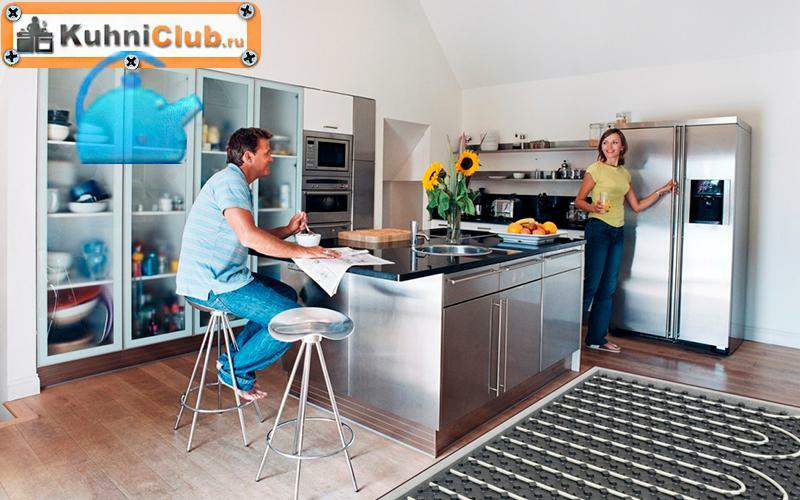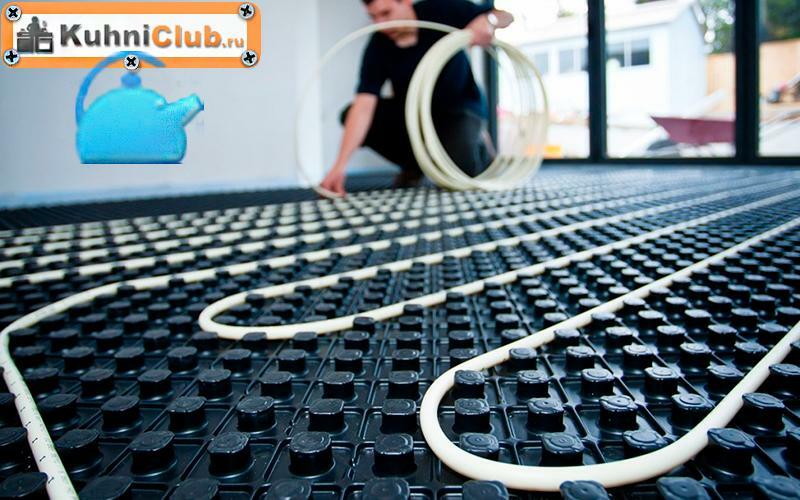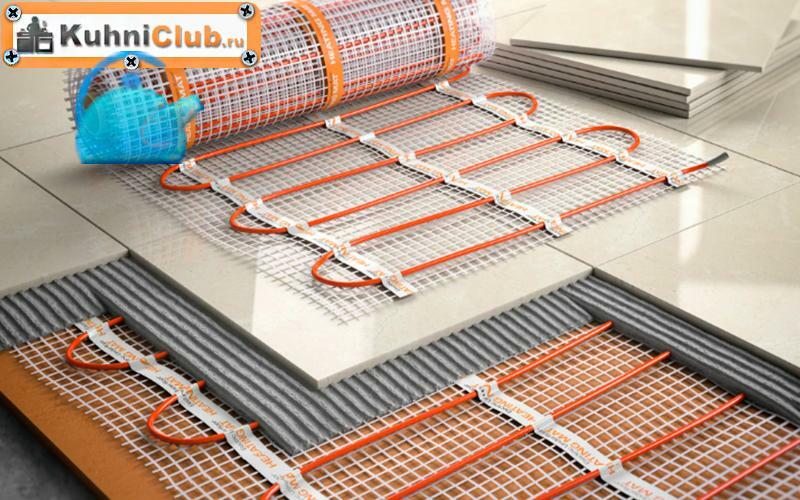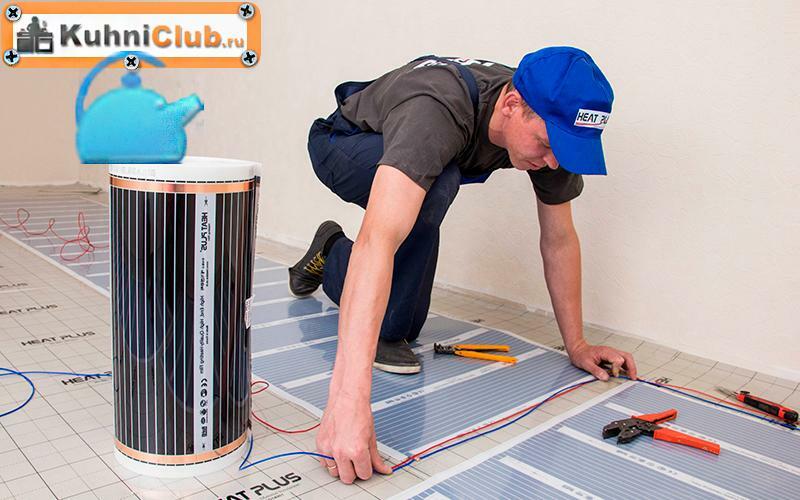All people are different. Some people like to be warm, while others prefer coolness. The same goes for underfloor heating in the kitchen. But how comfortable is the installation of a heating system for those who love "summer" and for those who love "winter"? In our article, we will consider the types of underfloor heating, as well as note the advantages and disadvantages of each of them.
Content
- Underfloor heating system in the kitchen. Advantages and disadvantages
- Types of warm floors
- Water heated floor
- Electric floor heating
- Film heating system
- Underfloor heating comparison. Video
Underfloor heating system in the kitchen. Advantages and disadvantages
Is underfloor heating the ideal heating system for a home? The answer is not unequivocal, but the following can be said for sure: with such a system, we get savings, aesthetics, pleasantness for the feet in the cold season, the absence of batteries in the walls under the windows, etc.
There is no need for underfloor heating if the kitchen windows face south or southwest. In this case, it will be warm enough in summer. But not in winter. Sometimes, even in summer, such an arrangement of the kitchen does not guarantee a comfortable temperature in the room, if, for example, the walls of the house do not protect from the winds. This is just one example. Therefore, whether a warm floor is needed in the kitchen is an individual question and depends on a number of circumstances.
Now let's move on to the positive side of the warm floor in the kitchen. Why is this system so popular in the modern world?

Advantages:
- Comfort. We get a comfortable floor and climate at any time of the year, because even in summer there are cold days. This is an ideal solution if there are small children in the house, the apartment is located on the ground floor or kitchen combined with a balcony / loggia.
- Underfloor heating is often alternative carpets in the kitchen. In this case, firstly, the time that was previously spent on cleaning carpets is saved (sometimes they are taken out into the street to be beaten out in the fresh air, including in the snow - a dubious pleasure). Secondly, it saves time and money for carpet cleaning.
- Good energy efficiency — a larger area is heated with less energy consumption.
- Uniformity of floor heating. However, clarification is needed here, since, out of economy, it is possible to place the system not around the entire perimeter of the kitchen, but excluding certain areas (kitchen set, household appliances, etc.) - and do not forget that the furniture can be rearranged! If you do not do heating under the built-in furniture, then after the repair it is possible that the built-in furniture will be dismantled, then cold spots will remain on the floor.
- Aesthetics is an important point of the advantages of the system. The absence of any equipment / wires makes the room spacious and unified. An exception is the mixing unit at the underfloor heating water system.
- Little joys in the form of fast drying drops of water on the floor, which is a frequent occurrence in the kitchen, as well as instant drying after mopping.
- Ease of temperature control, which makes it comfortable to stay in the kitchen.
- Long service life: 15 to 50 years depending on the system (see table below).
Flaws:
- inertia - the floor takes a long time to heat up and cool down for a long time. If the floor screed is thick, it takes a long time to heat and cool it. Therefore, if it becomes uncomfortably hot in the kitchen, you will have, firstly, to turn off the heated floor, and secondly, open a window for ventilation, and this is throwing money away for wasted energy for heating gender.
- Lack of air circulation. In this case, there is only one way out: ventilation. But here you need not to overdo it, so that heating the room is not a stupid waste of money.
- Heat buildup on the ceilingbecause light warm air always rises. The exception is the infrared system of underfloor heating.
- The warm floor is minus 10 cm of room height, which go to fill the system. In a kitchen with low ceilings, this can be a significant drawback.
Recommendations:
- Engineers recommend installing an underfloor heating system in the kitchen with porcelain stoneware (high thermal conductivity). In winter, this material is especially cold and warming it up is a must for creating comfort.
- Laminate, parquet board, linoleum, cork in the kitchen - these materials are not resistant to heat - from a constant temperature difference they will deform, and the service life will be reduced to a minimum. The efficiency of underfloor heating technology will also significantly decrease, since heat transfer will decrease (they conduct heat poorly, heat up for a long time). Some materials, when heated, can release harmful and dangerous substances (for example, linoleum).
- Cork has the lowest thermal conductivity, so this material not suitable for kitchens where installation is planned any underfloor heating system.
- Engineers recommend placing underfloor heating under the kitchen unit. At the same time, make an indent from the wall up to 30 cm. The heat will prevent condensation or mold from forming under built-in furniture. If we talk about the cable system of underfloor heating, the following nuance should be taken into account. The air gap between the kitchen furniture and the floor must be at least 5 cm; for the refrigerator dishwasher and other household appliances - at least 7-8 cm.
- If you have already decided to save money and not make underfloor heating under the headset itself, it is recommended not to deviate from it when laying the system, and to do it immediately from the border of the furniture. The reason is simple: it is in this space that the owner's legs are most often located.
- If a warm floor is laid around the entire perimeter of the kitchen, it must be remembered that the lower drawers of the headset will warm up a little. Therefore, their contents should not be affected/corrupted by heat.
Types of warm floors
Without going into the nuances, we can distinguish 2 types of underfloor heating, which we will talk about in more detail:
- water floor;
- Electric floor: cable and infrared systems.
Currently, the most popular underfloor heating are water And electrical systems. We will not delve into subtypes, but we will note the most important points for understanding the issue. Based on the name, it is clear what is included in the basis of each of the systems. The main thing that unites them is the ability to evenly heat the kitchen air.
But here it must be remembered that the floor itself is heated only where the system is laid, not a centimeter to the side. Well, maybe just a couple of centimeters on the sides, depending on the thickness of the floor screed.
Water heated floor
Underfloor heating can be the main source of heating for the kitchen (and the only one), but not only. When radiators are installed in the room, they are most often the main heating of the room, and the additional one is underfloor heating.
The installation of a water (or liquid) underfloor heating system is based on laying pipes in the form of a “snail” or “spiral”. Connected to the boiler, hot water of a given temperature runs through them. Depending on the pipe laying step, different system efficiency is obtained: a large step - less heat, a small step - more heat. In this case, with a small step, the main thing is not to overdo it, since you can get overheating of the surface. Water systems can heat the kitchen floor up to 50°C.

Advantages
- The system is mounted in kitchens of any humidity.
- Fire safety. There is no risk of short circuit, as well as electric shock.
- Perfect solution for the kitchen in a private houseas no permits are required for installation.
- High economy among the main systems of underfloor heating under the kitchen, even if forced supply (pump) is used. The reason is simple: once heated, after which it is only necessary to maintain the temperature.
- Applies with any kind of flooring (ceramic tiles, laminate, linoleum, carpet, etc.), since the installation is carried out in a screed, on which the listed materials are easily laid.
- Durability. Manufacturers of pipes for underfloor heating provide a guarantee of 50 years. Note that the warranty period for radiators is 5 years.
Flaws
- System Design more complex than the electrical system, since it is connected to the central heating of the house. It will not be easy to install it yourself. At the same time, the installation of the system is accompanied by a considerable amount of dust and dirt.
- One of the main disadvantages of the water system is pipes can burst. Therefore, it is important to make high-quality waterproofing and it is desirable to install a protection (control) system against water leaks.
- Difficulty repairing damage in the event of a pipeline leak, since the structure is under a thick layer of screed concrete. Moreover, finding the location of the problem will also be difficult.
- Concrete screed freezes for a long time, so fast installation can not be called.
- Getting permission for the installation of the system in an apartment building, since during installation it is necessary to connect to the central heating system.
- Water heating system cannot be installed above residential apartments. However, if the apartment is located on the ground floor or has its own heating, then a water floor can be installed.
- After installation the floor will rise 7 cm or more. For apartments with low ceilings, this can be a significant drawback.
- To install the system, you need complete dismantling of the flooring kitchens. Are you ready for this?
Electric floor heating
This type of underfloor heating works only on electricity. At the same time, there are several types of electric floors:
- A heating element - live cable high resistance. The heating range of cable floor type is from 15 to 30°C. This will be enough, because, unlike the water system, there will not be a thick layer of screed - it is simply not needed.

Electric underfloor heating with cable heating element -
Heating mats, mostly related to the cable type. The cable is initially fixed to a fiberglass mesh that is spread across the kitchen floor. We look at the photo below.

Electric underfloor heating with heating mats
Electric warmfloor has an average cooling time. As a recommendation, we note: the system lasts longer if it is turned on all the time, and does not turn on and off from time to time.
Advantages:
- More simple installation compared to a water floor.
- Electric heated floors safe, because they have an increased degree of protection, which minimizes electric shock or the occurrence of a short circuit.
- Suitable for mounting like in a private house and in an apartment.
- Electric heating system being installed for any floor covering: porcelain stoneware, laminate, linoleum, etc.
- It will become easy the only source of heating provided that the laying is at least 50% of the total kitchen area.
- Installing an electric floor will “steal” only 4 cm of the height of the room.
- Service life of 20 years.
Flaws:
- Large cash costs when using electrical structures, since power consumption increases.
- On electric underfloor heating not recommended to install heavy furniture (kitchen set, sofa, refrigerator, etc.) to avoid physical pressure on the cable, which can lead to overheating and even system failure. Laying heating in places where the owner will not walk is not economically feasible.
- Most often, an electric heating system is installed in tandem with radiators.
- Incorrect installation may turn out to be a fire hazard.
- Often go out of orderjoints heating elements.
Film heating system
Separately, let's say a few words about the film heating system.
Heat is released in the form of infrared waves due to the installation infrared film with carbon plates. The most simple (in terms of installation) type of electric underfloor heating is the use of infrared film. In this case, screed filling is not needed. Such a quick “dry” installation method can be mastered even by a non-professional, which makes the system the most popular.

- The film floor has the fastest heating time. For example, if the flooring is linoleum, the system heats up in 5 minutes. But when the power is turned off, it cools down just as quickly. Therefore, this advantage is also the main disadvantage of the film floor.
- The advantage of installing an infrared floor heating: the film will not take up additional space in the kitchen, that is, the thickness of the floor will remain almost unchanged.
- The infrared system is the most economical of electric underfloor heating.
- The infrared film is not compatible with ceramic tiles, as ceramic cannot be adhered to the film even if it is perforated. The film is also not compatible with a premium laminate that has metal inserts: metal and infrared film are not friendly.
- The supply of electricity to the heating elements of the infrared film is in the public domain, protected only by special overlays. Therefore, any drop of water in this place is guaranteed to give a short circuit and electric shock.
- The film does not heat the floor, but emits waves that heat what is located above the floor: furniture placed, household appliances, etc.
| water floor | electric floor | infrared floor | |
|---|---|---|---|
| Difficulty of installation | low complexity | low complexity | low complexity |
| Reliability, % | 99,9 | 40 | 70 |
| Maintainability of heating elements | low | low | high |
| Heating and cooling time | long | average | rapid |
| Floor Compatibility | any material other than cork | any material other than cork | any material except cork, ceramic tiles and laminate with metal inserts |
| Furniture compatibility | undesirable | undesirable | Not recommended |
| Humidity Compatibility | compatible | compatible | incompatible |
| Permission to install | limited permission | no permission required | no permission required |
| Economy | maximum | low | average |
| Service life, years | 50 | 15 | 15 |

